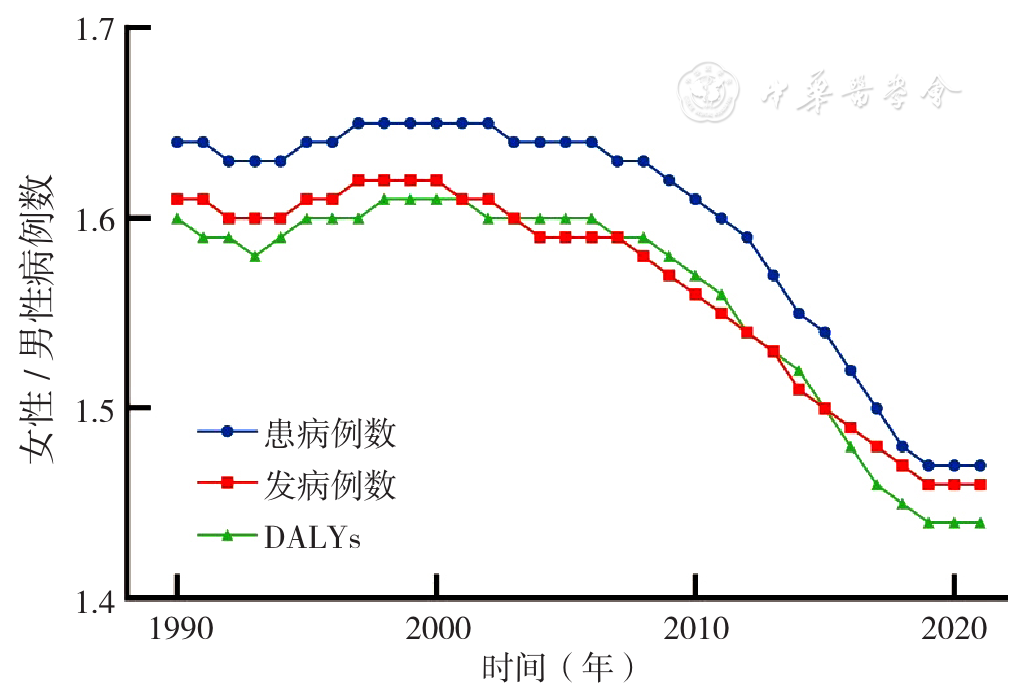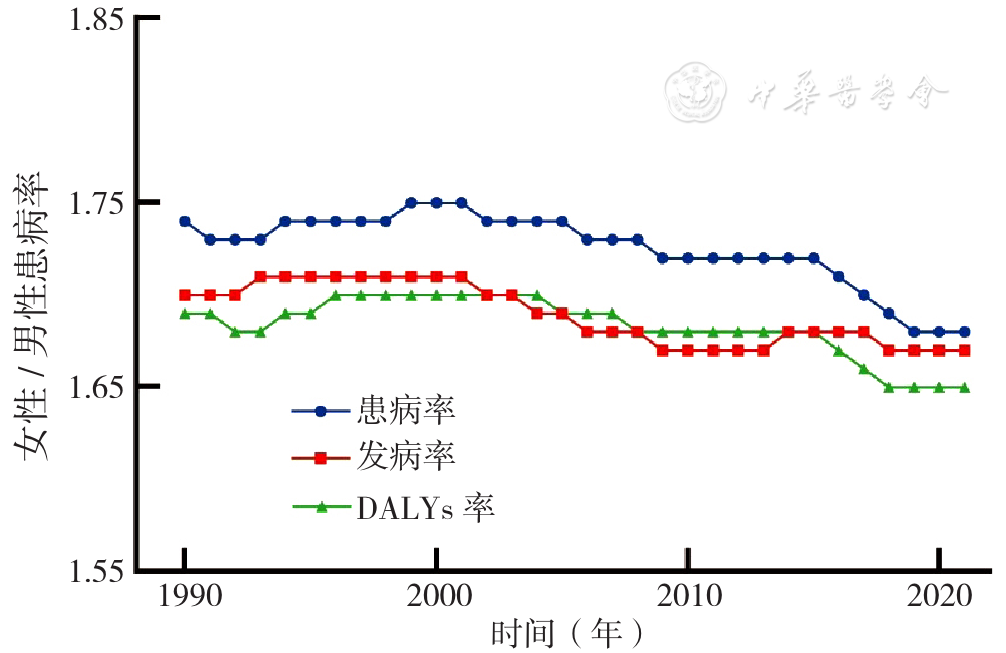中国全科医学 ›› 2025, Vol. 28 ›› Issue (15): 1923-1931.DOI: 10.12114/j.issn.1007-9572.2024.0397
收稿日期:2024-09-10
修回日期:2024-11-15
出版日期:2025-05-20
发布日期:2025-03-21
通讯作者:
徐含青
作者贡献:
李欣确定研究命题、研究思路并设计课题方案;李欣和罗莎负责数据的提取、清洗、整理;王红苹负责数据分析与图表制作;罗莎负责文献的搜集与整理;李欣负责撰写论文的初稿;徐含青负责论文的修订并控制论文的最终质量。
LI Xin1, LUO Sha1, WANG Hongping2, XU Hanqing1,*( )
)
Received:2024-09-10
Revised:2024-11-15
Published:2025-05-20
Online:2025-03-21
Contact:
XU Hanqing
摘要: 背景 目前关于中国10~24岁年轻人(简称年轻人)偏头痛疾病负担的系统研究有限。 目的 基于全球疾病负担数据库(GBD),探究2021年中国年轻人偏头痛疾病负担情况,并分析不同年龄、性别和时间模式下的变化情况。 方法 从2021年GBD(简称GBD 2021)中提取1990—2021年偏头痛相关数据,选取患病率、发病率、伤残调整寿命年(DALYs)率作为评估偏头痛疾病负担的指标。采用变化率及年均变化百分比(EAPC)评估1990—2021年年轻人偏头痛疾病负担变化趋势。 结果 2021年,中国年轻人偏头痛患病例数2 763.8万人(95%UI=2 145.5~3 505.2)、发病例数349.8万人(95%UI=273.5~427.5)、DALYs为103.0万人年(95%UI=9.2~249.6),均约占全球年轻人偏头痛总数的1/11,占中等社会发展指数(Middle SDI)地区年轻人偏头痛总数的30%左右。但患病率、发病率、DALYs率均低于全球平均水平和Middle SDI地区的水平;中国年轻人偏头痛患病率为11 809.0/10万,低于全球平均水平16 108.1/10万,同时也低于Middle SDI地区的16 455.8/10万。1990—2021年,中国年轻人偏头痛患病率、发病率和DALYs率均呈上升趋势,患病率从1990年的11 556.5(95%UI=9 120.2~14 491.3)/10万上升到2021年的11 809.0(95%UI=9 167.3~14 976.8)/10万,EAPC为0.28(95%CI=0.15~0.40),发病率从1990年的1 379.5(95%UI=1 075.3~1 708.2)/10万上升到2021年的1 494.6(95%UI=1 168.5~1 826.5)/10万,EAPC为0.17(95%CI=0.10~0.24),DALYs率从1990年的430.9(95%UI=42.0~1 033.0)/10万上升到2021年的440.2(95%UI=39.4~1 066.6)/10万,EAPC为0.29(95%CI=0.16~0.42)。与1990年相比,2021年中国年轻人偏头痛患病例数、发病例数和DALYs均减少约1/3。此外,中国年轻人偏头痛负担存在年龄和性别差异,其中10~14岁年龄组患病率、发病率和DALYs率上升趋势较明显,EAPC分别为0.28(95%CI=0.24~0.33)、0.27(95%CI=0.22~0.33)和0.29(95%CI=0.25~0.34)。中国年轻人女性偏头痛负担高于男性。2021年中国女性在10~14岁、15~19岁、20~24岁以及整个10~24岁年龄段中,女性的患病率、发病率和DALYs率约是男性的1.7倍。 结论 整体来说,2021年较1990年中国年轻人偏头痛患病例数、发病例数和DALYs均减少约1/3。但从过去32年的整体趋势看,患病率、发病率和DALYs率均呈上升趋势。性别方面,各年龄段女性年轻人偏头痛负担均高于男性。年龄方面,尽管目前中国10~14岁年龄段的年轻人偏头痛负担相对较轻,但其疾病负担增长速度最快。
中图分类号:
| 地区 | 患病例数(95%UI) (万人) | 患病率(95%UI) (1/10万) | 发病例数(95%UI) (万人) | 发病率(95%UI) (1/10万) | DALYs(95%UI) (万人年) | DALYs率(95%UI) (1/10万) |
|---|---|---|---|---|---|---|
| 中国 | 2 763.8(2 145.5~3 505.2) | 11 809.0(9 167.3~14 976.8) | 349.8(273.5~427.5) | 1 494.6(1 168.5~1 826.5) | 103.0(9.2~249.6) | 440.2(39.4~1 066.6) |
| 全球 | 30 408.4(23 557.0~37 931.7) | 16 108.1(12 478.7~20 093.3) | 3 442(2 730.8~4 220.3) | 1 823.3(1 446.6~2 235.6) | 1 122.0(87.1~2 727.6) | 594.4(46.2~1 444.9) |
| Middle SDI | 9 095.9(7 095.3~11 348.2) | 16 455.8(12 836.4~20 530.5) | 1 009.1(804.9~1 229.3) | 1 825.5(1 456.2~2 224.0) | 338.0(24.7~815.2) | 611.6(44.7~1 474.9) |
表1 2021年年轻人偏头痛负担:中国、全球及Middle SDI地区比较
Table 1 Comparison of adolescent migraine burden in 2021:China,global,and middle SDI region
| 地区 | 患病例数(95%UI) (万人) | 患病率(95%UI) (1/10万) | 发病例数(95%UI) (万人) | 发病率(95%UI) (1/10万) | DALYs(95%UI) (万人年) | DALYs率(95%UI) (1/10万) |
|---|---|---|---|---|---|---|
| 中国 | 2 763.8(2 145.5~3 505.2) | 11 809.0(9 167.3~14 976.8) | 349.8(273.5~427.5) | 1 494.6(1 168.5~1 826.5) | 103.0(9.2~249.6) | 440.2(39.4~1 066.6) |
| 全球 | 30 408.4(23 557.0~37 931.7) | 16 108.1(12 478.7~20 093.3) | 3 442(2 730.8~4 220.3) | 1 823.3(1 446.6~2 235.6) | 1 122.0(87.1~2 727.6) | 594.4(46.2~1 444.9) |
| Middle SDI | 9 095.9(7 095.3~11 348.2) | 16 455.8(12 836.4~20 530.5) | 1 009.1(804.9~1 229.3) | 1 825.5(1 456.2~2 224.0) | 338.0(24.7~815.2) | 611.6(44.7~1 474.9) |
| 年龄(岁) | 患病例数(95%UI)(万人) | 变化率(%) | 患病率(95%UI)(1/10万) | EAPC (95%CI) | ||
|---|---|---|---|---|---|---|
| 1990年 | 2021年 | 1990年 | 2021年 | |||
| 10~14 | 768.1(570.9~1 035.3) | 694.9(517.0~919.2) | -10.0 | 7 508.7(5 580.9~10 121.1) | 8 062.1(5 998.0~10 664.0) | 0.28(0.24~0.33) |
| 15~19 | 1 523.5(1 140.5~1 981.9) | 959.4(705.8~1 247.3) | -37 .0 | 12 028.0(9 003.7~15 647.0) | 12 847.8(9 451.8~16 703.9) | 0.25(0.20~0.30) |
| 20~24 | 1 879.8(1 463.5~2 368.5) | 1 109.5(851.9~1 401.8) | -41.0 | 14 240.9(11 086.8~17 943.2) | 15 162.5(11 641.9~19 156.5) | 0.23(0.19~0.28) |
| 10~24 | 4 171.4(3 292.0~5 230.8) | 2 763.8(2 145.5~3 505.2) | -34.0 | 11 556.5(9 120.2~14 491.3) | 11 809.0(9 167.3~14 976.8) | 0.28(0.15~0.40) |
表2 1990—2021年中国年轻人间偏头痛患病负担年龄段变化趋势对比
Table 2 Comparison of trends in migraine prevalence burden among young people in China from 1990 to 2021 by age group
| 年龄(岁) | 患病例数(95%UI)(万人) | 变化率(%) | 患病率(95%UI)(1/10万) | EAPC (95%CI) | ||
|---|---|---|---|---|---|---|
| 1990年 | 2021年 | 1990年 | 2021年 | |||
| 10~14 | 768.1(570.9~1 035.3) | 694.9(517.0~919.2) | -10.0 | 7 508.7(5 580.9~10 121.1) | 8 062.1(5 998.0~10 664.0) | 0.28(0.24~0.33) |
| 15~19 | 1 523.5(1 140.5~1 981.9) | 959.4(705.8~1 247.3) | -37 .0 | 12 028.0(9 003.7~15 647.0) | 12 847.8(9 451.8~16 703.9) | 0.25(0.20~0.30) |
| 20~24 | 1 879.8(1 463.5~2 368.5) | 1 109.5(851.9~1 401.8) | -41.0 | 14 240.9(11 086.8~17 943.2) | 15 162.5(11 641.9~19 156.5) | 0.23(0.19~0.28) |
| 10~24 | 4 171.4(3 292.0~5 230.8) | 2 763.8(2 145.5~3 505.2) | -34.0 | 11 556.5(9 120.2~14 491.3) | 11 809.0(9 167.3~14 976.8) | 0.28(0.15~0.40) |
| 年龄(岁) | 发病例数(95%UI)(万人) | 变化率(%) | 发病率(95%UI)(1/10万) | EAPC (95%CI) | ||
|---|---|---|---|---|---|---|
| 1990年 | 2021年 | 1990年 | 2021年 | |||
| 10~14 | 167.6(120.9~219.0) | 151.5(108.8~199.9) | -10.0 | 1 638.8(1 182.0~2 141.3) | 1 757.4(1 262.2~2 319.0) | 0.27(0.22~0.33) |
| 15~19 | 167.5(103.6~248.2) | 104.3(64.1~152.5) | -38.0 | 1 322(817.9~1 959.1) | 1 396.7(858.9~2 042.3) | 0.16(0.10~0.22) |
| 20~24 | 162.8(102.2~240.2) | 94.0(60.5~138.7) | -42.0 | 1 233.6(774.4~1 820.0) | 1 284.9(827.3~1 896.0) | 0.11(0.06~0.16) |
| 10~24 | 497.9(388.1~616.6) | 349.8(273.5~427.5) | -30.0 | 1 379.5(1 075.3~1 708.2) | 1 494.6(1 168.5~1 826.5) | 0.17(0.10~0.24) |
表3 1990—2021年中国年轻人偏头痛发病负担年龄段变化趋势对比
Table 3 Comparison of trends in migraine incidence burden among young people in China from 1990 to 2021 by age group
| 年龄(岁) | 发病例数(95%UI)(万人) | 变化率(%) | 发病率(95%UI)(1/10万) | EAPC (95%CI) | ||
|---|---|---|---|---|---|---|
| 1990年 | 2021年 | 1990年 | 2021年 | |||
| 10~14 | 167.6(120.9~219.0) | 151.5(108.8~199.9) | -10.0 | 1 638.8(1 182.0~2 141.3) | 1 757.4(1 262.2~2 319.0) | 0.27(0.22~0.33) |
| 15~19 | 167.5(103.6~248.2) | 104.3(64.1~152.5) | -38.0 | 1 322(817.9~1 959.1) | 1 396.7(858.9~2 042.3) | 0.16(0.10~0.22) |
| 20~24 | 162.8(102.2~240.2) | 94.0(60.5~138.7) | -42.0 | 1 233.6(774.4~1 820.0) | 1 284.9(827.3~1 896.0) | 0.11(0.06~0.16) |
| 10~24 | 497.9(388.1~616.6) | 349.8(273.5~427.5) | -30.0 | 1 379.5(1 075.3~1 708.2) | 1 494.6(1 168.5~1 826.5) | 0.17(0.10~0.24) |
| 年龄(岁) | DALYs(95%UI)(万人年) | 变化率(%) | DALYs率(95%UI) | EAPC (95%CI) | ||
|---|---|---|---|---|---|---|
| 1990年 | 2021年 | 1990年 | 2021年 | |||
| 10~14 | 27.9(1.6~68.6) | 25.3(1.4~61.1) | -9.0 | 272.3(16.1~670.7) | 293.1(15.8~709.4) | 0.29(0.25~0.34) |
| 15~19 | 57.3(5.8~136.2) | 36.1(3.4~84.9) | -37.0 | 452.2(45.7~1 075.7) | 483.7(45.5~1 136.7) | 0.26(0.21~0.3) |
| 20~24 | 70.4(7.8~172.2) | 41.6(4.3~100.7) | -41.0 | 533.4(58.9~1 304.9) | 569.1(58.7~1 376.5) | 0.24(0.20~0.29) |
| 10~24 | 155.5(15.2~372.9) | 103.0(9.2~249.6) | -34.0 | 430.9(42.0~1 033.0) | 440.2(39.4~1 066.6) | 0.29(0.16~0.42) |
表4 1990—2021年中国年轻人偏头痛DALYs负担年龄段变化趋势分析
Table 4 Comparison of trends in migraine DALYs burden among young people in China from 1990 to 2021 by age group
| 年龄(岁) | DALYs(95%UI)(万人年) | 变化率(%) | DALYs率(95%UI) | EAPC (95%CI) | ||
|---|---|---|---|---|---|---|
| 1990年 | 2021年 | 1990年 | 2021年 | |||
| 10~14 | 27.9(1.6~68.6) | 25.3(1.4~61.1) | -9.0 | 272.3(16.1~670.7) | 293.1(15.8~709.4) | 0.29(0.25~0.34) |
| 15~19 | 57.3(5.8~136.2) | 36.1(3.4~84.9) | -37.0 | 452.2(45.7~1 075.7) | 483.7(45.5~1 136.7) | 0.26(0.21~0.3) |
| 20~24 | 70.4(7.8~172.2) | 41.6(4.3~100.7) | -41.0 | 533.4(58.9~1 304.9) | 569.1(58.7~1 376.5) | 0.24(0.20~0.29) |
| 10~24 | 155.5(15.2~372.9) | 103.0(9.2~249.6) | -34.0 | 430.9(42.0~1 033.0) | 440.2(39.4~1 066.6) | 0.29(0.16~0.42) |

图1 1990—2021年中国年轻人偏头痛患病例数、发病例数与DALYs及其率的变化趋势分析注:A~C分别表示患病、发病、DALYs病例数变化趋势;D~F分别表示患病率、发病率和DALYs率的变化趋势。
Figure 1 Analysis of the trends in migraine prevalence,incidence,and DALYs cases and rates among Chinese young people from 1990 to 2021
| 年龄(岁) | 性别 | 患病例数(95%UI) (万人) | 患病率(95%UI) (1/10万) | 发病例数(95%UI) (万人) | 发病率(95%UI) (1/10万) | DALYs(95%UI) (万人年) | DALYs率(95%UI) (1/10万) |
|---|---|---|---|---|---|---|---|
| 10~14 | 女性 | 419.4(307.5~561.6) | 10 433.1(7 649.0~13 970.3) | 90.7(65.1~118.9) | 2 257.0(1 620.5~2 957.3) | 15.3(0.7~38.0) | 379.5(18.2~944.7) |
| 男性 | 275.5(205.7~365.6) | 5 989.8(4 471.4~7 949.6) | 60.7(43.1~82.5) | 1 320.7(936.3~1 792.8) | 10.0(0.7~26.0) | 217.5(14.4~566.0) | |
| 合计 | 694.9(517.0~919.2) | 8 062.1(5 998.0~10 664.0) | 151.5(108.8~199.9) | 1 757.4(1 262.2~2 319.0) | 25.3(1.4~61.1) | 293.1(15.8~709.4) | |
| 15~19 | 女性 | 567.5(418.4~736.1) | 16 407.5(12 095.1~21 281.9) | 60.9(37.2~89.5) | 1 760.6(1 075.6~2 586.2) | 21.2(1.6~51.0) | 612.9(47.4~1 474.7) |
| 男性 | 391.9(289.9~512.9) | 9 776.1(7 232.5~12 796.9) | 43.4(27.0~63.9) | 1 082.8(673.2~1 594.3) | 14.9(1.7~35.3) | 372.2(42.8~881.3) | |
| 合计 | 959.4(705.8~1 247.3) | 12 847.8(9 451.8~16 703.9) | 104.3(64.1~152.5) | 1 396.7(858.9~2 042.3) | 36.1(3.4~84.9) | 483.7(45.5~1 136.7) | |
| 20~24 | 女性 | 656.5(497.7~823.0) | 19 135.6(14 506.9~23 988.8) | 56.0(35.8~83.0) | 1 632.3(1 044.7~2 418.5) | 24.3(2.1~56.9) | 708.7(61.5~1 658.3) |
| 男性 | 453.0(347.2~579.4) | 11 655.6(8 934.1~14 907.1) | 38.0(23.9~56.1) | 978.3(615.0~1 443.2) | 17.3(2.2~41.8) | 445.9(56.2~1 075.9) | |
| 合计 | 1 109.5(851.9~1 401.8) | 15 162.5(11 641.9~19 156.5) | 94.0(60.5~138.7) | 1 284.9(827.3~1 896.0) | 41.6(4.3~100.7) | 569.1(58.7~1 376.5) | |
| 10~24 | 女性 | 1 643.4(1 284.0~2 066.3) | 15 063.9(11 769.8~18 940.4) | 207.6(163.4~252.8) | 1 903.2(1 497.8~2 317.5) | 60.8(4.6~147.6) | 557.0(42.4~1 352.6) |
| 男性 | 1 120.4(859.7~1 452.2) | 8 967.0(6 881.1~11 623.1) | 142.2(109.5~177.9) | 1 137.9(876.5~1 424.0) | 42.3(4.5~104.5) | 338.2(35.8~836.7) | |
| 合计 | 2 763.8(2 145.5~3 505.2) | 11 809.0(9 167.3~14 976.8) | 349.8(273.5~427.5) | 1 494.6(1 168.5~1 826.5) | 103.0(9.2~249.6) | 440.2(39.4~1 066.6) |
表5 2021年中国不同年龄段年轻人偏头痛性别趋势分析
Table 5 Analysis of gender trends in adolescent migraine across different age groups in China in 2021
| 年龄(岁) | 性别 | 患病例数(95%UI) (万人) | 患病率(95%UI) (1/10万) | 发病例数(95%UI) (万人) | 发病率(95%UI) (1/10万) | DALYs(95%UI) (万人年) | DALYs率(95%UI) (1/10万) |
|---|---|---|---|---|---|---|---|
| 10~14 | 女性 | 419.4(307.5~561.6) | 10 433.1(7 649.0~13 970.3) | 90.7(65.1~118.9) | 2 257.0(1 620.5~2 957.3) | 15.3(0.7~38.0) | 379.5(18.2~944.7) |
| 男性 | 275.5(205.7~365.6) | 5 989.8(4 471.4~7 949.6) | 60.7(43.1~82.5) | 1 320.7(936.3~1 792.8) | 10.0(0.7~26.0) | 217.5(14.4~566.0) | |
| 合计 | 694.9(517.0~919.2) | 8 062.1(5 998.0~10 664.0) | 151.5(108.8~199.9) | 1 757.4(1 262.2~2 319.0) | 25.3(1.4~61.1) | 293.1(15.8~709.4) | |
| 15~19 | 女性 | 567.5(418.4~736.1) | 16 407.5(12 095.1~21 281.9) | 60.9(37.2~89.5) | 1 760.6(1 075.6~2 586.2) | 21.2(1.6~51.0) | 612.9(47.4~1 474.7) |
| 男性 | 391.9(289.9~512.9) | 9 776.1(7 232.5~12 796.9) | 43.4(27.0~63.9) | 1 082.8(673.2~1 594.3) | 14.9(1.7~35.3) | 372.2(42.8~881.3) | |
| 合计 | 959.4(705.8~1 247.3) | 12 847.8(9 451.8~16 703.9) | 104.3(64.1~152.5) | 1 396.7(858.9~2 042.3) | 36.1(3.4~84.9) | 483.7(45.5~1 136.7) | |
| 20~24 | 女性 | 656.5(497.7~823.0) | 19 135.6(14 506.9~23 988.8) | 56.0(35.8~83.0) | 1 632.3(1 044.7~2 418.5) | 24.3(2.1~56.9) | 708.7(61.5~1 658.3) |
| 男性 | 453.0(347.2~579.4) | 11 655.6(8 934.1~14 907.1) | 38.0(23.9~56.1) | 978.3(615.0~1 443.2) | 17.3(2.2~41.8) | 445.9(56.2~1 075.9) | |
| 合计 | 1 109.5(851.9~1 401.8) | 15 162.5(11 641.9~19 156.5) | 94.0(60.5~138.7) | 1 284.9(827.3~1 896.0) | 41.6(4.3~100.7) | 569.1(58.7~1 376.5) | |
| 10~24 | 女性 | 1 643.4(1 284.0~2 066.3) | 15 063.9(11 769.8~18 940.4) | 207.6(163.4~252.8) | 1 903.2(1 497.8~2 317.5) | 60.8(4.6~147.6) | 557.0(42.4~1 352.6) |
| 男性 | 1 120.4(859.7~1 452.2) | 8 967.0(6 881.1~11 623.1) | 142.2(109.5~177.9) | 1 137.9(876.5~1 424.0) | 42.3(4.5~104.5) | 338.2(35.8~836.7) | |
| 合计 | 2 763.8(2 145.5~3 505.2) | 11 809.0(9 167.3~14 976.8) | 349.8(273.5~427.5) | 1 494.6(1 168.5~1 826.5) | 103.0(9.2~249.6) | 440.2(39.4~1 066.6) |

图2 1990—2021年中国年轻人偏头痛女性/男性患病例数、发病例数和DALYs变化趋势
Figure 2 Analysis of the trends in migraine prevalence,incidence,and DALYs among female and male Chinese young people from 1990 to 2021

图3 1990—2021年中国年轻人偏头痛女性/男性患病率、发病率和DALYs率变化趋势
Figure 3 Analysis of the trends in migraine prevalence,incidence,and DALYs rates among female and male Chinese young people from 1990 to 2021
| [1] |
Headache Classification Committee of the International Headache Society(IHS). The international classification of headache disorders,3rd edition[J]. Cephalalgia,2018,38(1):1-211. DOI:10.1177/0333102417738202.
|
| [2] |
GBD 2016 Headache Collaborators. Global,regional,and national burden of migraine and tension-type headache,1990-2016:a systematic analysis for the Global Burden of Disease Study 2016[J]. Lancet Neurol,2018,17(11):954-976. DOI:10.1016/S1474-4422(18)30322-3.
|
| [3] |
|
| [4] |
|
| [5] |
|
| [6] |
|
| [7] |
|
| [8] |
|
| [9] |
|
| [10] |
GBD 2019 Diseases and Injuries Collaborators. Global burden of 369 diseases and injuries in 204 countries and territories,1990-2019:a systematic analysis for the Global Burden of Disease Study 2019[J]. Lancet,2020,396(10258):1204-1222. DOI:10.1016/S0140-6736(20)30925-9.
|
| [11] |
GBD 2021 Diseases and Injuries Collaborators. Global incidence,prevalence,years lived with disability(YLDs),disability-adjusted life-years(DALYs),and healthy life expectancy(HALE)for 371 diseases and injuries in 204 countries and territories and 811 subnational locations,1990-2021:a systematic analysis for the Global Burden of Disease Study 2021[J]. Lancet,2024,403(10440):2133-2161. DOI:10.1016/S0140-6736(24)00757-8.
|
| [12] |
|
| [13] |
|
| [14] |
|
| [15] |
|
| [16] |
诺华.诺华预防偏头痛创新药安默唯®在中国获批用于成人偏头痛的预防性治疗[EB/OL].(2023-09-21)[2024-08-29].
|
| [17] |
中国医师协会神经内科医师分会.中国偏头痛诊治指南(2022版)[J].中国疼痛医学杂志,2022,28(12):881-898. DOI:10.3969/j.issn.1006-9852.2022.12.001.
|
| [18] |
GBD 2019 Demographics Collaborators. Global age-sex-specific fertility,mortality,healthy life expectancy(HALE),and population estimates in 204 countries and territories,1950-2019:a comprehensive demographic analysis for the Global Burden of Disease Study 2019[J]. Lancet,2020,396(10258):1160-1203. DOI:10.1016/S0140-6736(20)30977-6.
|
| [19] |
|
| [20] |
|
| [21] | |
| [22] |
|
| [23] |
|
| [24] |
|
| [25] |
|
| [26] |
|
| [27] |
|
| [28] |
|
| [29] |
|
| [30] |
|
| [31] |
|
| [32] |
|
| [33] |
|
| [34] |
|
| [35] |
|
| [36] |
GBD 2019 Risk Factors Collaborators. Global burden of 87 risk factors in 204 countries and territories,1990-2019:a systematic analysis for the Global Burden of Disease Study 2019[J]. Lancet,2020,396(10258):1223-1249. DOI:10.1016/S0140-6736(20)30752-2.
|
| [1] | 赵晓晓, 柯立鑫, 荀杨芹, 王海博, 高武霖, 乔天慈, 卢笑晖, 武继彪, 卢存存. 1990—2021年全球与中国老年2型糖尿病的疾病负担调查与未来趋势预测[J]. 中国全科医学, 2025, 28(16): 2050-2058. |
| [2] | 令垚, 张文滨, 王仕鸿, 陈永泽, 董文娇, 邓星妤, 丁元林. 1990—2021年中国类风湿关节炎疾病负担变化趋势分析及预测研究[J]. 中国全科医学, 2025, 28(15): 1914-1922. |
| [3] | 徐军, 高亚南, 徐涯鑫, 姚亭, 陈亚梅. 炎症性肠病患者疾病负担的潜在剖面分析及其影响因素研究[J]. 中国全科医学, 2025, 28(14): 1744-1750. |
| [4] | 颜丹虹, 甘同舟, 袁空军, 周光清. 1990—2019年中国高BMI所致的疾病负担分析与预测研究[J]. 中国全科医学, 2025, 28(10): 1200-1206. |
| [5] | 廖星雨, 田思雨, 陈敏. 1990—2021年中国与全球不同性别早发型结直肠癌的疾病负担和危险因素及预测研究[J]. 中国全科医学, 2025, 28(08): 1004-1011. |
| [6] | 韩树奎, 任义涛, 马昕, 宋盼盼, 马金祥, 张紫钰, 陈虹汝. 1992—2021年中国老年人群阿尔茨海默症及相关痴呆的疾病负担变化趋势及预测研究[J]. 中国全科医学, 2025, 28(08): 996-1003. |
| [7] | 姜申, 吴静, 周佳丽, 蒋德楠, 孙炜迪, 程思清, 朱思雨, 侯乐莹, 宋培歌. 童年逆境与成年期高血压患病的研究进展[J]. 中国全科医学, 2025, 28(03): 358-364. |
| [8] | 吴霞, 张译匀, 姚承志, 赵湘铃, 熊文婧, 让蔚清. 1990—2021年中国归因于饮食因素的缺血性心脏病疾病负担变化趋势及预测研究[J]. 中国全科医学, 2025, 28(03): 305-312. |
| [9] | 刘明波, 何新叶, 杨晓红, 王增武. 《中国心血管健康与疾病报告2023》要点解读[J]. 中国全科医学, 2025, 28(01): 20-38. |
| [10] | 张瑜, 于硕, 王冰清, 冉青青, 张夏芸. 2018—2023年上海市普陀区7~18岁儿童青少年中心性肥胖变化趋势分析[J]. 中国全科医学, 2024, 27(33): 4168-4175. |
| [11] | 刘娟, 赵晶, 陈泽雯, 李昌, 李丹龄, 付蓉. 摇头倾斜抑制试验和视频头脉冲试验鉴别前庭性偏头痛和梅尼埃病的应用研究[J]. 中国全科医学, 2024, 27(32): 3993-4000. |
| [12] | 张馨月, 张良文, 方亚. 中国1990—2019年代谢因素对缺血性心脏病疾病负担的长期影响及趋势研究[J]. 中国全科医学, 2024, 27(27): 3388-3394. |
| [13] | 苏未, 张颖, 马爽. 1990—2019年中国和全球缺血性心脏病疾病负担变化趋势与发病预测分析[J]. 中国全科医学, 2024, 27(19): 2375-2381. |
| [14] | 马学锋, 黄俊, 李娜, 邵慧娟, 卢利霞, 于晓辉, 张久聪. 1990—2019年中国胃食管反流病疾病负担分析及年变化趋势研究[J]. 中国全科医学, 2024, 27(18): 2265-2271. |
| [15] | 黄港, 曹桂莹, 刘民. 1990—2019年中国龋病的疾病负担现状及变化趋势研究[J]. 中国全科医学, 2024, 27(14): 1735-1741. |
| 阅读次数 | ||||||
|
全文 |
|
|||||
|
摘要 |
|
|||||





